Strategic Marketing Audit & Analysis of Spa Ceylon (MKTM028)
VerifiedAdded on 2023/07/24
|21
|4294
|238
Report
AI Summary
This report presents a comprehensive marketing audit of Spa Ceylon, a luxury ayurvedic brand in Sri Lanka. It includes a macro analysis using PESTEL, covering political, economic, social, technological, environmental, and legal factors, and a micro analysis examining the market, customers, competitors, distribution, and suppliers. The report reviews Spa Ceylon's strategies and functions, assesses productivity, and develops a TWOS matrix to identify threats and opportunities. Key strategic challenges are highlighted, such as maintaining unique product offerings, expanding market reach beyond current outlets and hotels, and addressing social and cultural influences. The analysis incorporates frameworks like Porter’s Five Forces, the marketing mix, and the BCG matrix to evaluate Spa Ceylon's competitive position and growth potential. The report concludes that Spa Ceylon has successfully established its brand and contributes to the Sri Lankan economy and Ayurvedic practices.
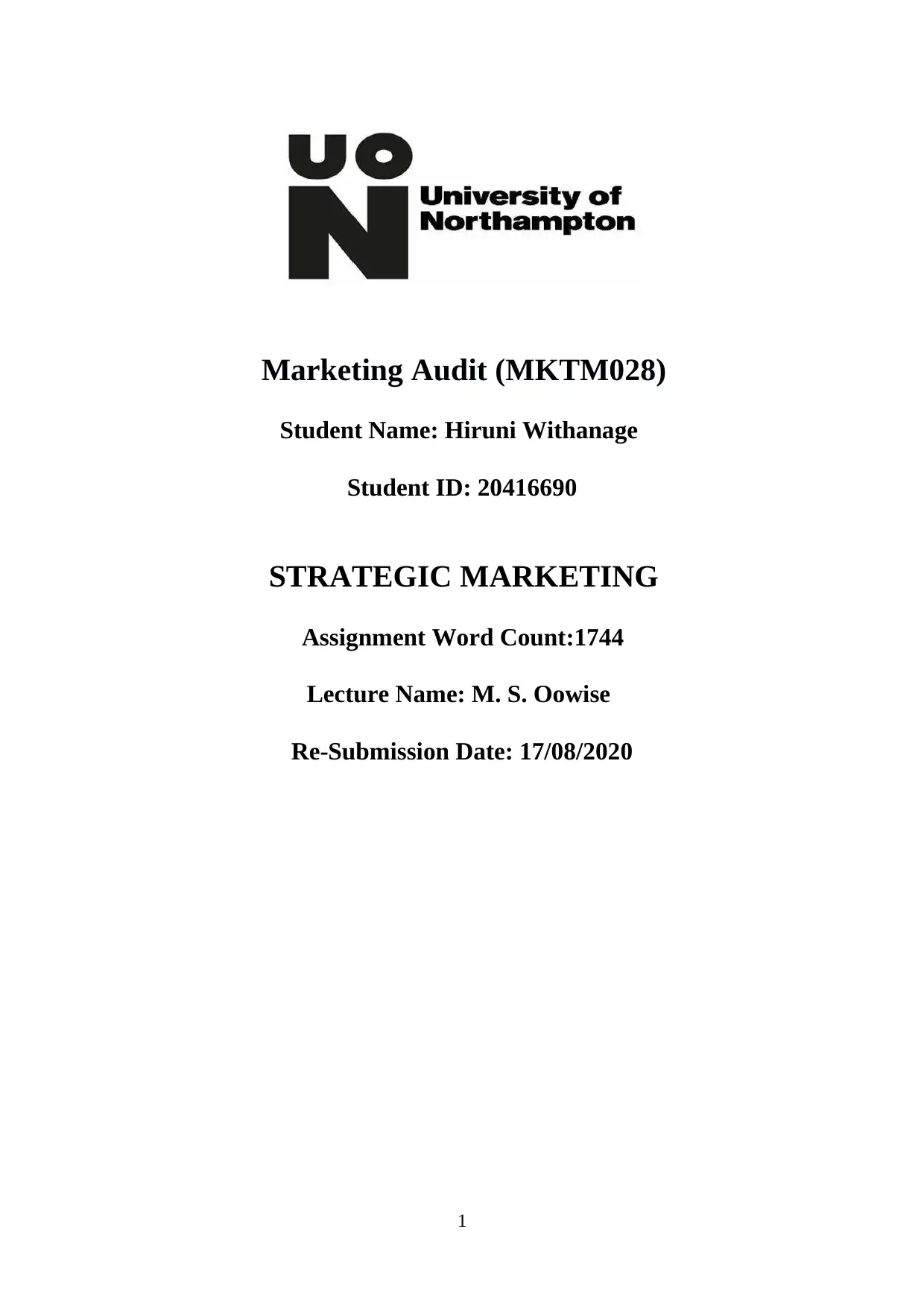
Marketing Audit (MKTM028)
Student Name: Hiruni Withanage
Student ID: 20416690
STRATEGIC MARKETING
Assignment Word Count:1744
Lecture Name: M. S. Oowise
Re-Submission Date: 17/08/2020
1
Student Name: Hiruni Withanage
Student ID: 20416690
STRATEGIC MARKETING
Assignment Word Count:1744
Lecture Name: M. S. Oowise
Re-Submission Date: 17/08/2020
1
Paraphrase This Document
Need a fresh take? Get an instant paraphrase of this document with our AI Paraphraser
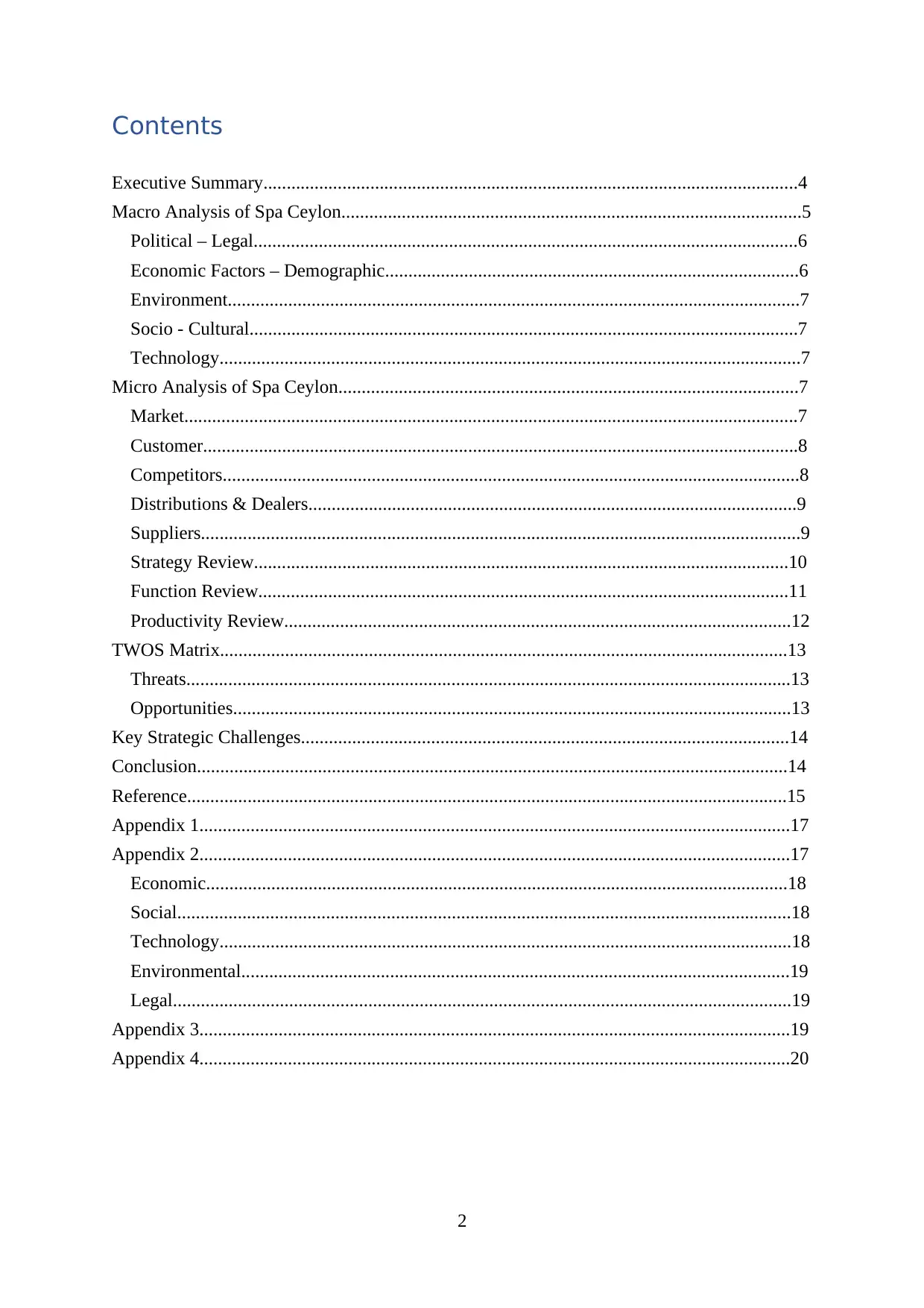
Contents
Executive Summary...................................................................................................................4
Macro Analysis of Spa Ceylon...................................................................................................5
Political – Legal.....................................................................................................................6
Economic Factors – Demographic.........................................................................................6
Environment...........................................................................................................................7
Socio - Cultural......................................................................................................................7
Technology.............................................................................................................................7
Micro Analysis of Spa Ceylon...................................................................................................7
Market....................................................................................................................................7
Customer................................................................................................................................8
Competitors............................................................................................................................8
Distributions & Dealers.........................................................................................................9
Suppliers.................................................................................................................................9
Strategy Review...................................................................................................................10
Function Review..................................................................................................................11
Productivity Review.............................................................................................................12
TWOS Matrix..........................................................................................................................13
Threats..................................................................................................................................13
Opportunities........................................................................................................................13
Key Strategic Challenges.........................................................................................................14
Conclusion...............................................................................................................................14
Reference.................................................................................................................................15
Appendix 1...............................................................................................................................17
Appendix 2...............................................................................................................................17
Economic.............................................................................................................................18
Social....................................................................................................................................18
Technology...........................................................................................................................18
Environmental......................................................................................................................19
Legal.....................................................................................................................................19
Appendix 3...............................................................................................................................19
Appendix 4...............................................................................................................................20
2
Executive Summary...................................................................................................................4
Macro Analysis of Spa Ceylon...................................................................................................5
Political – Legal.....................................................................................................................6
Economic Factors – Demographic.........................................................................................6
Environment...........................................................................................................................7
Socio - Cultural......................................................................................................................7
Technology.............................................................................................................................7
Micro Analysis of Spa Ceylon...................................................................................................7
Market....................................................................................................................................7
Customer................................................................................................................................8
Competitors............................................................................................................................8
Distributions & Dealers.........................................................................................................9
Suppliers.................................................................................................................................9
Strategy Review...................................................................................................................10
Function Review..................................................................................................................11
Productivity Review.............................................................................................................12
TWOS Matrix..........................................................................................................................13
Threats..................................................................................................................................13
Opportunities........................................................................................................................13
Key Strategic Challenges.........................................................................................................14
Conclusion...............................................................................................................................14
Reference.................................................................................................................................15
Appendix 1...............................................................................................................................17
Appendix 2...............................................................................................................................17
Economic.............................................................................................................................18
Social....................................................................................................................................18
Technology...........................................................................................................................18
Environmental......................................................................................................................19
Legal.....................................................................................................................................19
Appendix 3...............................................................................................................................19
Appendix 4...............................................................................................................................20
2
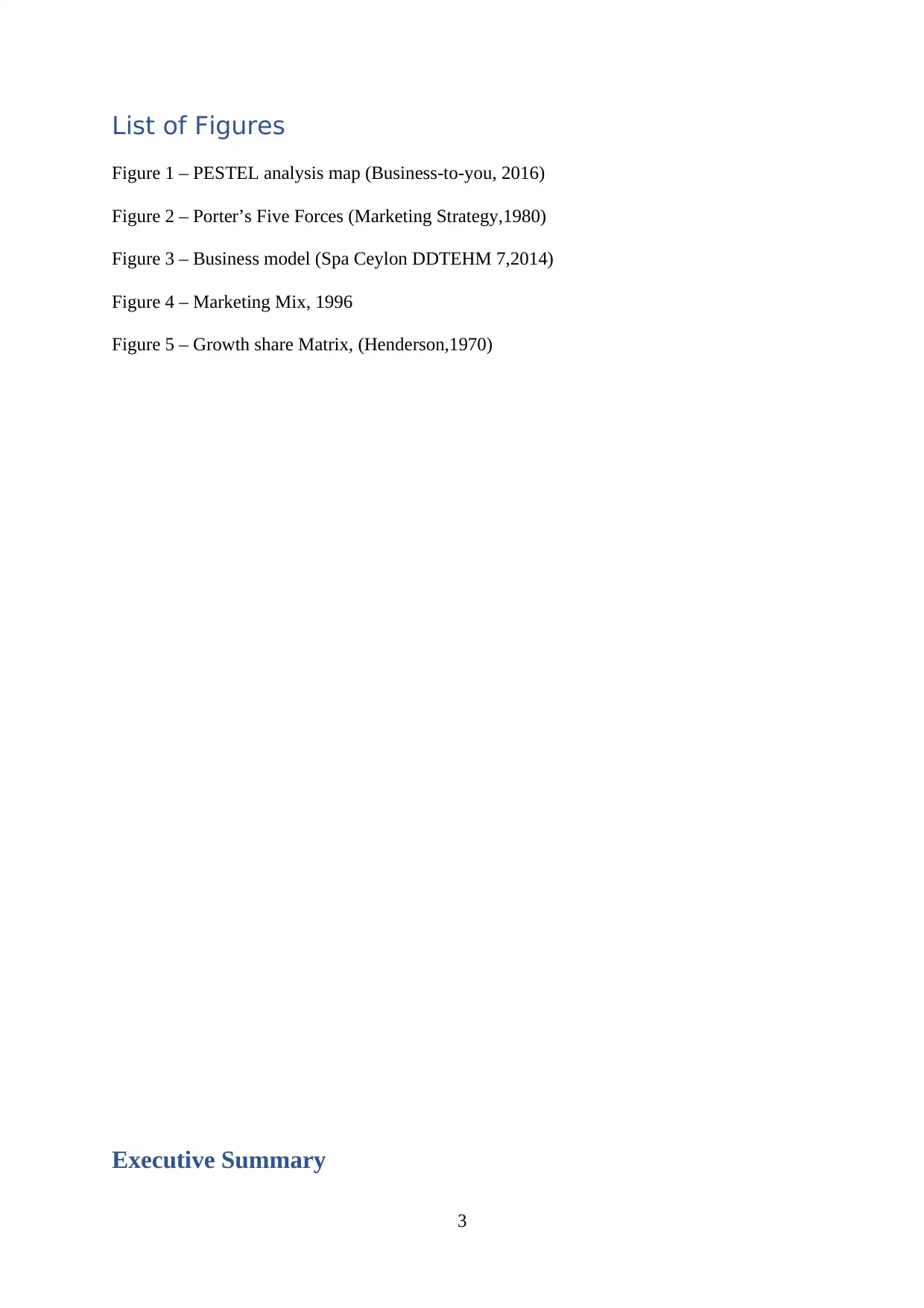
List of Figures
Figure 1 – PESTEL analysis map (Business-to-you, 2016)
Figure 2 – Porter’s Five Forces (Marketing Strategy,1980)
Figure 3 – Business model (Spa Ceylon DDTEHM 7,2014)
Figure 4 – Marketing Mix, 1996
Figure 5 – Growth share Matrix, (Henderson,1970)
Executive Summary
3
Figure 1 – PESTEL analysis map (Business-to-you, 2016)
Figure 2 – Porter’s Five Forces (Marketing Strategy,1980)
Figure 3 – Business model (Spa Ceylon DDTEHM 7,2014)
Figure 4 – Marketing Mix, 1996
Figure 5 – Growth share Matrix, (Henderson,1970)
Executive Summary
3
⊘ This is a preview!⊘
Do you want full access?
Subscribe today to unlock all pages.

Trusted by 1+ million students worldwide
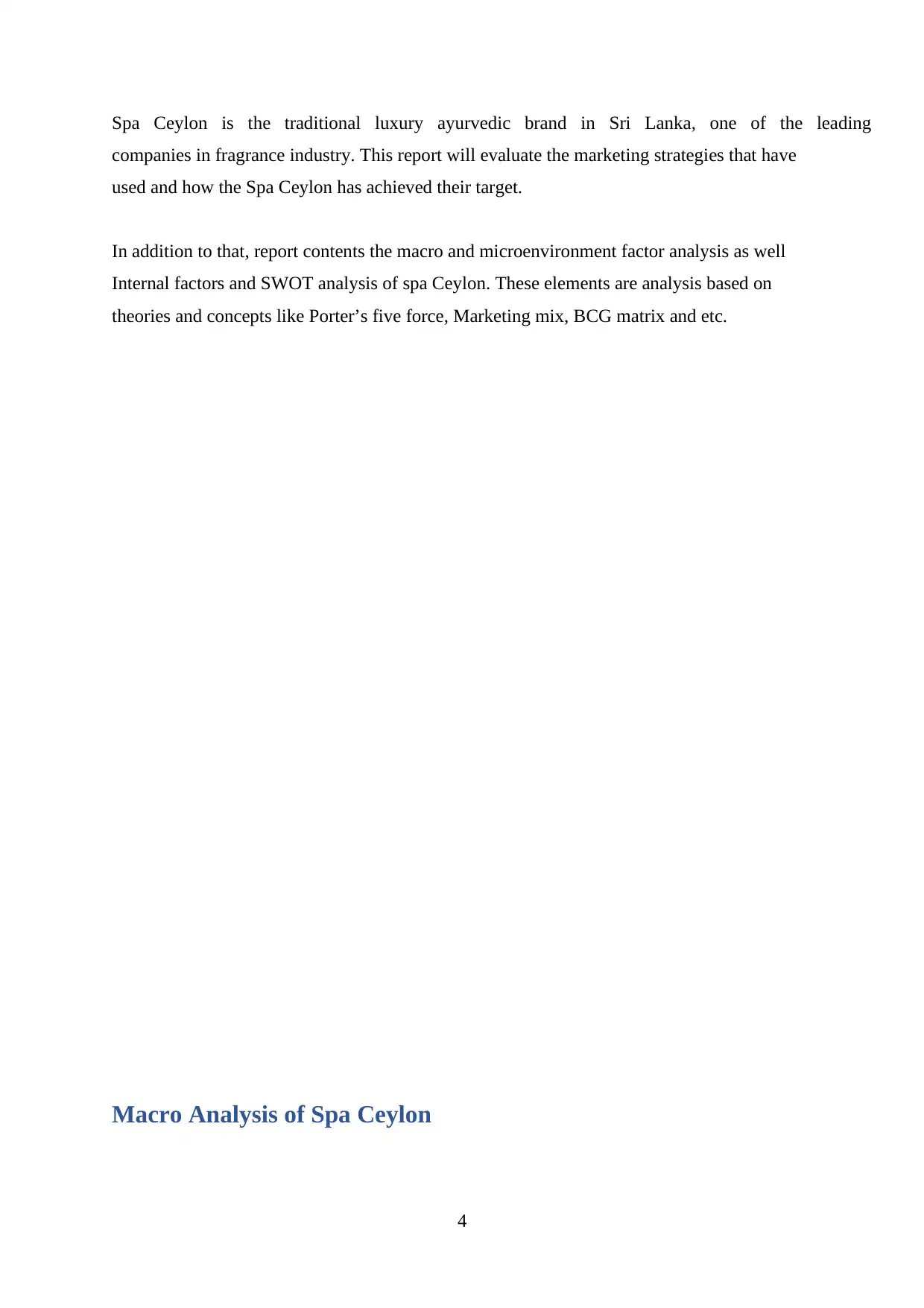
Spa Ceylon is the traditional luxury ayurvedic brand in Sri Lanka, one of the leading
companies in fragrance industry. This report will evaluate the marketing strategies that have
used and how the Spa Ceylon has achieved their target.
In addition to that, report contents the macro and microenvironment factor analysis as well
Internal factors and SWOT analysis of spa Ceylon. These elements are analysis based on
theories and concepts like Porter’s five force, Marketing mix, BCG matrix and etc.
Macro Analysis of Spa Ceylon
4
companies in fragrance industry. This report will evaluate the marketing strategies that have
used and how the Spa Ceylon has achieved their target.
In addition to that, report contents the macro and microenvironment factor analysis as well
Internal factors and SWOT analysis of spa Ceylon. These elements are analysis based on
theories and concepts like Porter’s five force, Marketing mix, BCG matrix and etc.
Macro Analysis of Spa Ceylon
4
Paraphrase This Document
Need a fresh take? Get an instant paraphrase of this document with our AI Paraphraser
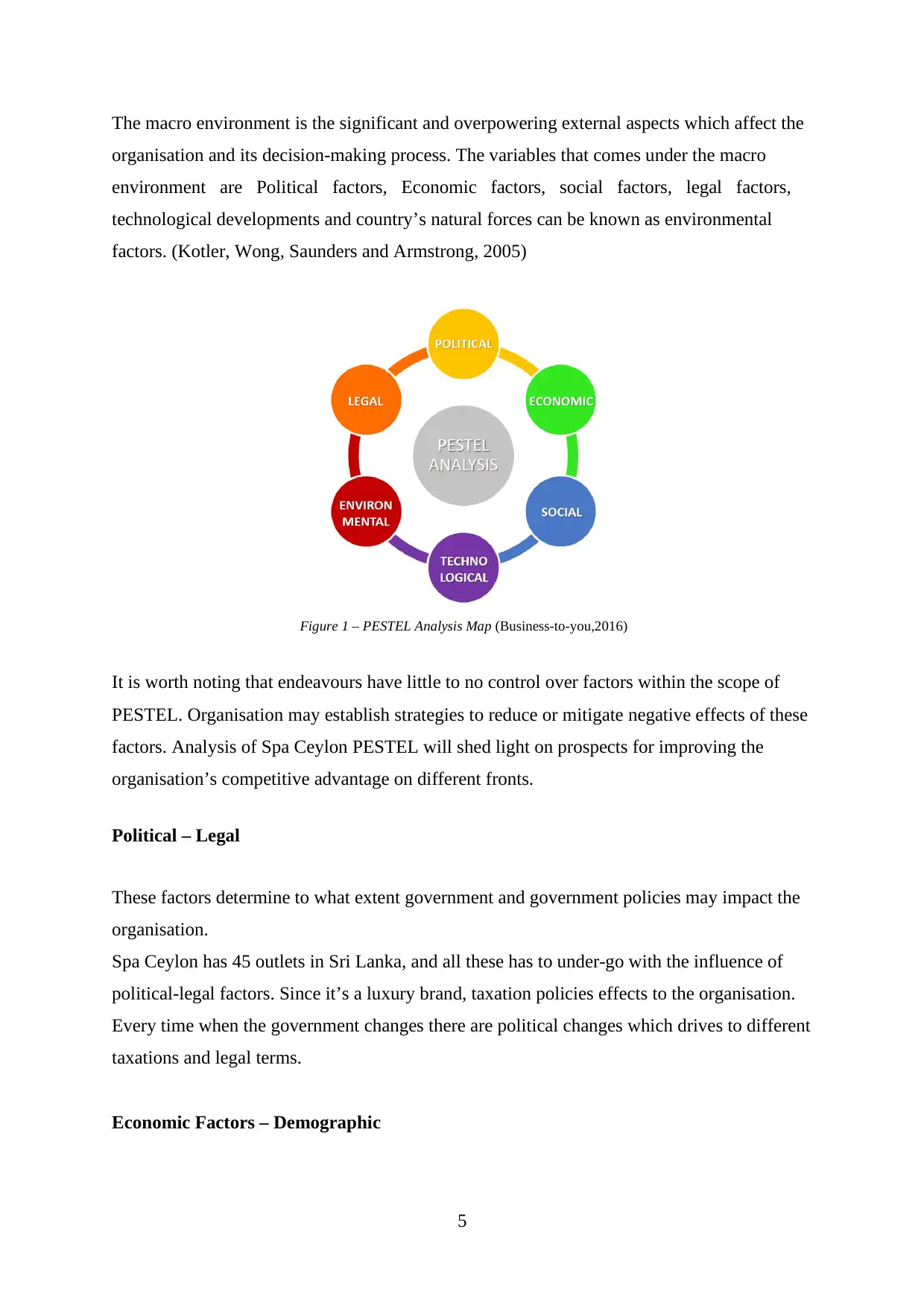
The macro environment is the significant and overpowering external aspects which affect the
organisation and its decision-making process. The variables that comes under the macro
environment are Political factors, Economic factors, social factors, legal factors,
technological developments and country’s natural forces can be known as environmental
factors. (Kotler, Wong, Saunders and Armstrong, 2005)
Figure 1 – PESTEL Analysis Map (Business-to-you,2016)
It is worth noting that endeavours have little to no control over factors within the scope of
PESTEL. Organisation may establish strategies to reduce or mitigate negative effects of these
factors. Analysis of Spa Ceylon PESTEL will shed light on prospects for improving the
organisation’s competitive advantage on different fronts.
Political – Legal
These factors determine to what extent government and government policies may impact the
organisation.
Spa Ceylon has 45 outlets in Sri Lanka, and all these has to under-go with the influence of
political-legal factors. Since it’s a luxury brand, taxation policies effects to the organisation.
Every time when the government changes there are political changes which drives to different
taxations and legal terms.
Economic Factors – Demographic
5
organisation and its decision-making process. The variables that comes under the macro
environment are Political factors, Economic factors, social factors, legal factors,
technological developments and country’s natural forces can be known as environmental
factors. (Kotler, Wong, Saunders and Armstrong, 2005)
Figure 1 – PESTEL Analysis Map (Business-to-you,2016)
It is worth noting that endeavours have little to no control over factors within the scope of
PESTEL. Organisation may establish strategies to reduce or mitigate negative effects of these
factors. Analysis of Spa Ceylon PESTEL will shed light on prospects for improving the
organisation’s competitive advantage on different fronts.
Political – Legal
These factors determine to what extent government and government policies may impact the
organisation.
Spa Ceylon has 45 outlets in Sri Lanka, and all these has to under-go with the influence of
political-legal factors. Since it’s a luxury brand, taxation policies effects to the organisation.
Every time when the government changes there are political changes which drives to different
taxations and legal terms.
Economic Factors – Demographic
5
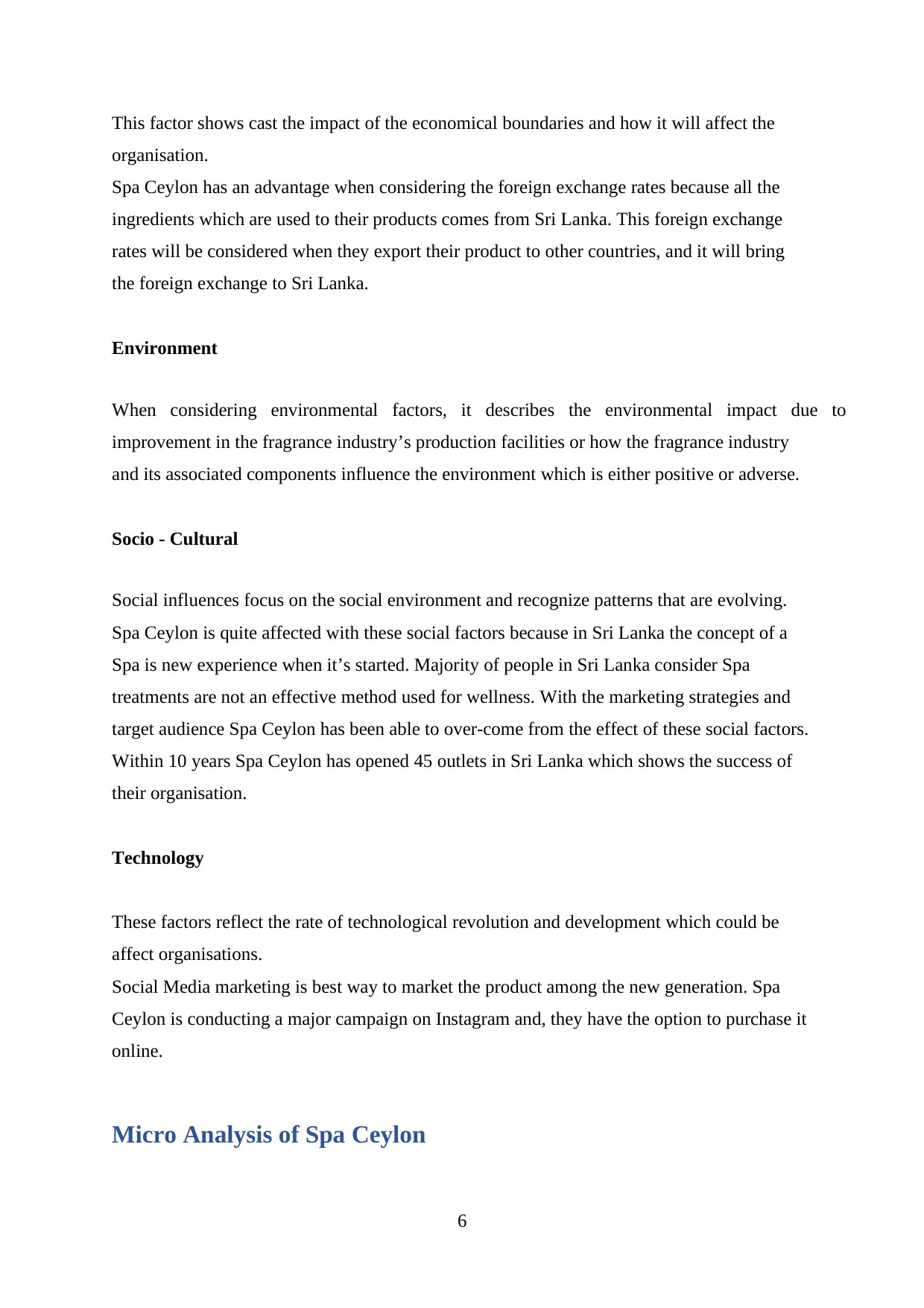
This factor shows cast the impact of the economical boundaries and how it will affect the
organisation.
Spa Ceylon has an advantage when considering the foreign exchange rates because all the
ingredients which are used to their products comes from Sri Lanka. This foreign exchange
rates will be considered when they export their product to other countries, and it will bring
the foreign exchange to Sri Lanka.
Environment
When considering environmental factors, it describes the environmental impact due to
improvement in the fragrance industry’s production facilities or how the fragrance industry
and its associated components influence the environment which is either positive or adverse.
Socio - Cultural
Social influences focus on the social environment and recognize patterns that are evolving.
Spa Ceylon is quite affected with these social factors because in Sri Lanka the concept of a
Spa is new experience when it’s started. Majority of people in Sri Lanka consider Spa
treatments are not an effective method used for wellness. With the marketing strategies and
target audience Spa Ceylon has been able to over-come from the effect of these social factors.
Within 10 years Spa Ceylon has opened 45 outlets in Sri Lanka which shows the success of
their organisation.
Technology
These factors reflect the rate of technological revolution and development which could be
affect organisations.
Social Media marketing is best way to market the product among the new generation. Spa
Ceylon is conducting a major campaign on Instagram and, they have the option to purchase it
online.
Micro Analysis of Spa Ceylon
6
organisation.
Spa Ceylon has an advantage when considering the foreign exchange rates because all the
ingredients which are used to their products comes from Sri Lanka. This foreign exchange
rates will be considered when they export their product to other countries, and it will bring
the foreign exchange to Sri Lanka.
Environment
When considering environmental factors, it describes the environmental impact due to
improvement in the fragrance industry’s production facilities or how the fragrance industry
and its associated components influence the environment which is either positive or adverse.
Socio - Cultural
Social influences focus on the social environment and recognize patterns that are evolving.
Spa Ceylon is quite affected with these social factors because in Sri Lanka the concept of a
Spa is new experience when it’s started. Majority of people in Sri Lanka consider Spa
treatments are not an effective method used for wellness. With the marketing strategies and
target audience Spa Ceylon has been able to over-come from the effect of these social factors.
Within 10 years Spa Ceylon has opened 45 outlets in Sri Lanka which shows the success of
their organisation.
Technology
These factors reflect the rate of technological revolution and development which could be
affect organisations.
Social Media marketing is best way to market the product among the new generation. Spa
Ceylon is conducting a major campaign on Instagram and, they have the option to purchase it
online.
Micro Analysis of Spa Ceylon
6
⊘ This is a preview!⊘
Do you want full access?
Subscribe today to unlock all pages.

Trusted by 1+ million students worldwide
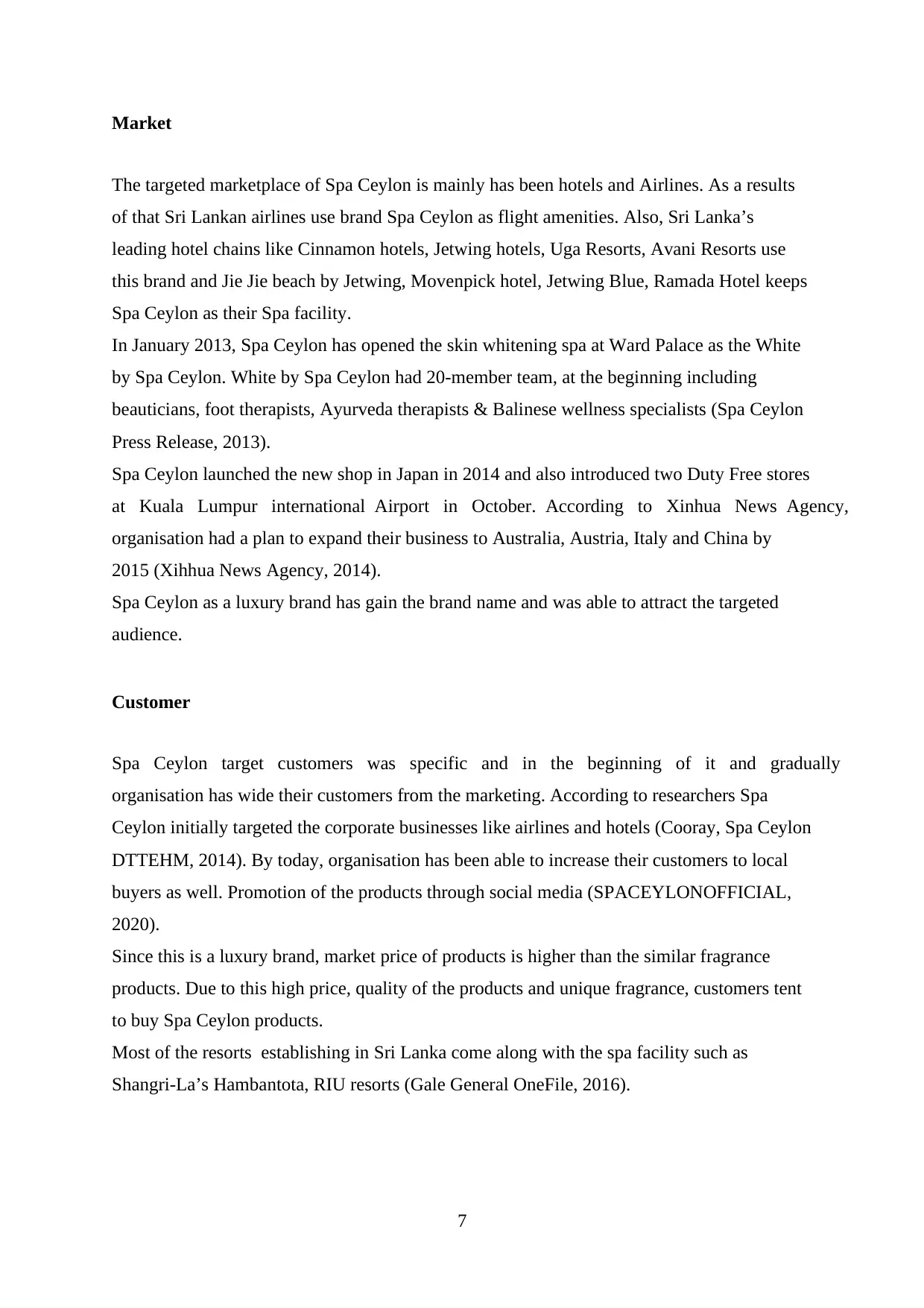
Market
The targeted marketplace of Spa Ceylon is mainly has been hotels and Airlines. As a results
of that Sri Lankan airlines use brand Spa Ceylon as flight amenities. Also, Sri Lanka’s
leading hotel chains like Cinnamon hotels, Jetwing hotels, Uga Resorts, Avani Resorts use
this brand and Jie Jie beach by Jetwing, Movenpick hotel, Jetwing Blue, Ramada Hotel keeps
Spa Ceylon as their Spa facility.
In January 2013, Spa Ceylon has opened the skin whitening spa at Ward Palace as the White
by Spa Ceylon. White by Spa Ceylon had 20-member team, at the beginning including
beauticians, foot therapists, Ayurveda therapists & Balinese wellness specialists (Spa Ceylon
Press Release, 2013).
Spa Ceylon launched the new shop in Japan in 2014 and also introduced two Duty Free stores
at Kuala Lumpur international Airport in October. According to Xinhua News Agency,
organisation had a plan to expand their business to Australia, Austria, Italy and China by
2015 (Xihhua News Agency, 2014).
Spa Ceylon as a luxury brand has gain the brand name and was able to attract the targeted
audience.
Customer
Spa Ceylon target customers was specific and in the beginning of it and gradually
organisation has wide their customers from the marketing. According to researchers Spa
Ceylon initially targeted the corporate businesses like airlines and hotels (Cooray, Spa Ceylon
DTTEHM, 2014). By today, organisation has been able to increase their customers to local
buyers as well. Promotion of the products through social media (SPACEYLONOFFICIAL,
2020).
Since this is a luxury brand, market price of products is higher than the similar fragrance
products. Due to this high price, quality of the products and unique fragrance, customers tent
to buy Spa Ceylon products.
Most of the resorts establishing in Sri Lanka come along with the spa facility such as
Shangri-La’s Hambantota, RIU resorts (Gale General OneFile, 2016).
7
The targeted marketplace of Spa Ceylon is mainly has been hotels and Airlines. As a results
of that Sri Lankan airlines use brand Spa Ceylon as flight amenities. Also, Sri Lanka’s
leading hotel chains like Cinnamon hotels, Jetwing hotels, Uga Resorts, Avani Resorts use
this brand and Jie Jie beach by Jetwing, Movenpick hotel, Jetwing Blue, Ramada Hotel keeps
Spa Ceylon as their Spa facility.
In January 2013, Spa Ceylon has opened the skin whitening spa at Ward Palace as the White
by Spa Ceylon. White by Spa Ceylon had 20-member team, at the beginning including
beauticians, foot therapists, Ayurveda therapists & Balinese wellness specialists (Spa Ceylon
Press Release, 2013).
Spa Ceylon launched the new shop in Japan in 2014 and also introduced two Duty Free stores
at Kuala Lumpur international Airport in October. According to Xinhua News Agency,
organisation had a plan to expand their business to Australia, Austria, Italy and China by
2015 (Xihhua News Agency, 2014).
Spa Ceylon as a luxury brand has gain the brand name and was able to attract the targeted
audience.
Customer
Spa Ceylon target customers was specific and in the beginning of it and gradually
organisation has wide their customers from the marketing. According to researchers Spa
Ceylon initially targeted the corporate businesses like airlines and hotels (Cooray, Spa Ceylon
DTTEHM, 2014). By today, organisation has been able to increase their customers to local
buyers as well. Promotion of the products through social media (SPACEYLONOFFICIAL,
2020).
Since this is a luxury brand, market price of products is higher than the similar fragrance
products. Due to this high price, quality of the products and unique fragrance, customers tent
to buy Spa Ceylon products.
Most of the resorts establishing in Sri Lanka come along with the spa facility such as
Shangri-La’s Hambantota, RIU resorts (Gale General OneFile, 2016).
7
Paraphrase This Document
Need a fresh take? Get an instant paraphrase of this document with our AI Paraphraser
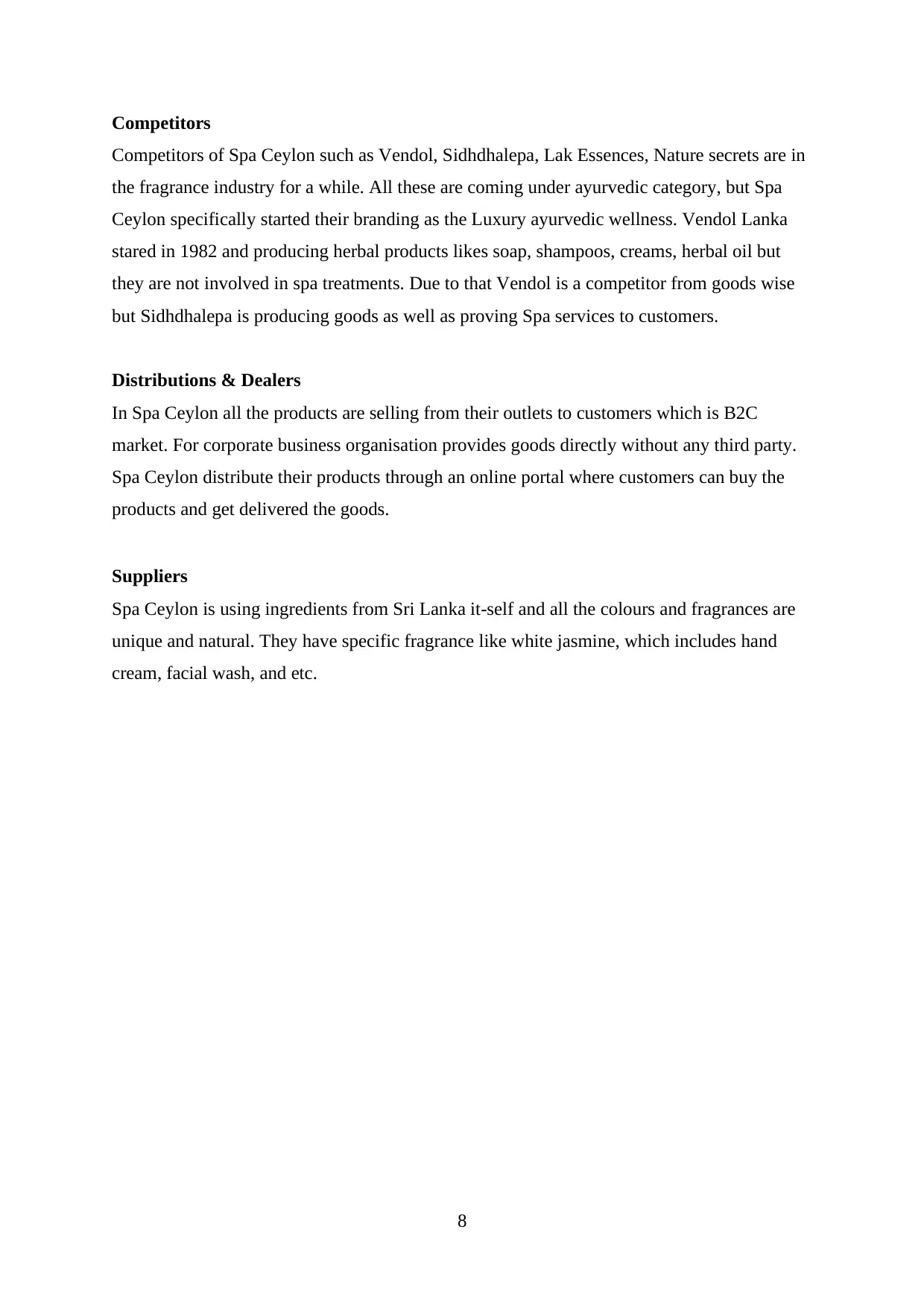
Competitors
Competitors of Spa Ceylon such as Vendol, Sidhdhalepa, Lak Essences, Nature secrets are in
the fragrance industry for a while. All these are coming under ayurvedic category, but Spa
Ceylon specifically started their branding as the Luxury ayurvedic wellness. Vendol Lanka
stared in 1982 and producing herbal products likes soap, shampoos, creams, herbal oil but
they are not involved in spa treatments. Due to that Vendol is a competitor from goods wise
but Sidhdhalepa is producing goods as well as proving Spa services to customers.
Distributions & Dealers
In Spa Ceylon all the products are selling from their outlets to customers which is B2C
market. For corporate business organisation provides goods directly without any third party.
Spa Ceylon distribute their products through an online portal where customers can buy the
products and get delivered the goods.
Suppliers
Spa Ceylon is using ingredients from Sri Lanka it-self and all the colours and fragrances are
unique and natural. They have specific fragrance like white jasmine, which includes hand
cream, facial wash, and etc.
8
Competitors of Spa Ceylon such as Vendol, Sidhdhalepa, Lak Essences, Nature secrets are in
the fragrance industry for a while. All these are coming under ayurvedic category, but Spa
Ceylon specifically started their branding as the Luxury ayurvedic wellness. Vendol Lanka
stared in 1982 and producing herbal products likes soap, shampoos, creams, herbal oil but
they are not involved in spa treatments. Due to that Vendol is a competitor from goods wise
but Sidhdhalepa is producing goods as well as proving Spa services to customers.
Distributions & Dealers
In Spa Ceylon all the products are selling from their outlets to customers which is B2C
market. For corporate business organisation provides goods directly without any third party.
Spa Ceylon distribute their products through an online portal where customers can buy the
products and get delivered the goods.
Suppliers
Spa Ceylon is using ingredients from Sri Lanka it-self and all the colours and fragrances are
unique and natural. They have specific fragrance like white jasmine, which includes hand
cream, facial wash, and etc.
8
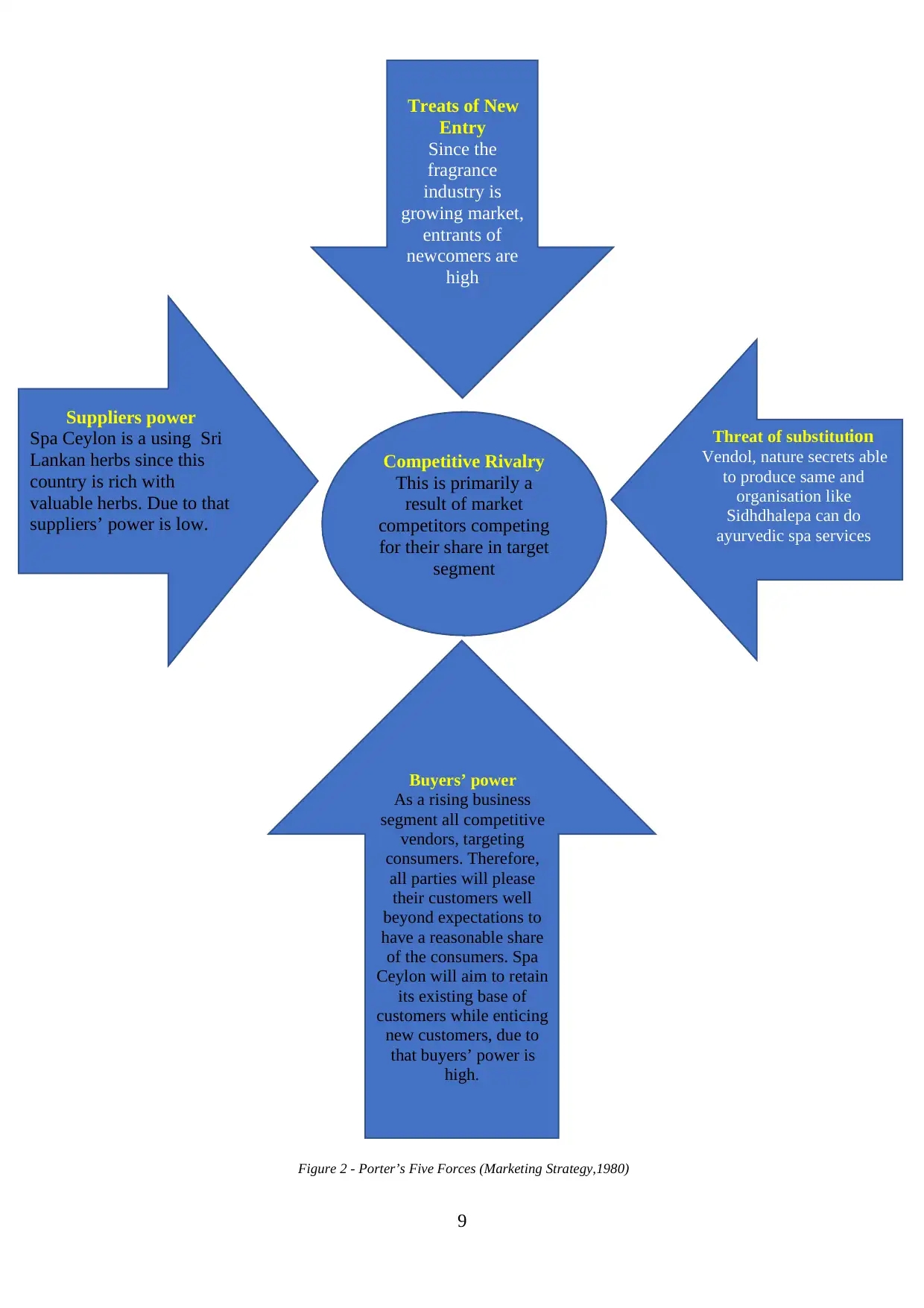
Buyer Power
Figure 2 - Porter’s Five Forces (Marketing Strategy,1980)
9
Treats of New
Entry
Since the
fragrance
industry is
growing market,
entrants of
newcomers are
high
Suppliers power
Spa Ceylon is a using Sri
Lankan herbs since this
country is rich with
valuable herbs. Due to that
suppliers’ power is low.
Threat of substitution
Vendol, nature secrets able
to produce same and
organisation like
Sidhdhalepa can do
ayurvedic spa services
Competitive Rivalry
This is primarily a
result of market
competitors competing
for their share in target
segment
Buyers’ power
As a rising business
segment all competitive
vendors, targeting
consumers. Therefore,
all parties will please
their customers well
beyond expectations to
have a reasonable share
of the consumers. Spa
Ceylon will aim to retain
its existing base of
customers while enticing
new customers, due to
that buyers’ power is
high.
Figure 2 - Porter’s Five Forces (Marketing Strategy,1980)
9
Treats of New
Entry
Since the
fragrance
industry is
growing market,
entrants of
newcomers are
high
Suppliers power
Spa Ceylon is a using Sri
Lankan herbs since this
country is rich with
valuable herbs. Due to that
suppliers’ power is low.
Threat of substitution
Vendol, nature secrets able
to produce same and
organisation like
Sidhdhalepa can do
ayurvedic spa services
Competitive Rivalry
This is primarily a
result of market
competitors competing
for their share in target
segment
Buyers’ power
As a rising business
segment all competitive
vendors, targeting
consumers. Therefore,
all parties will please
their customers well
beyond expectations to
have a reasonable share
of the consumers. Spa
Ceylon will aim to retain
its existing base of
customers while enticing
new customers, due to
that buyers’ power is
high.
⊘ This is a preview!⊘
Do you want full access?
Subscribe today to unlock all pages.

Trusted by 1+ million students worldwide
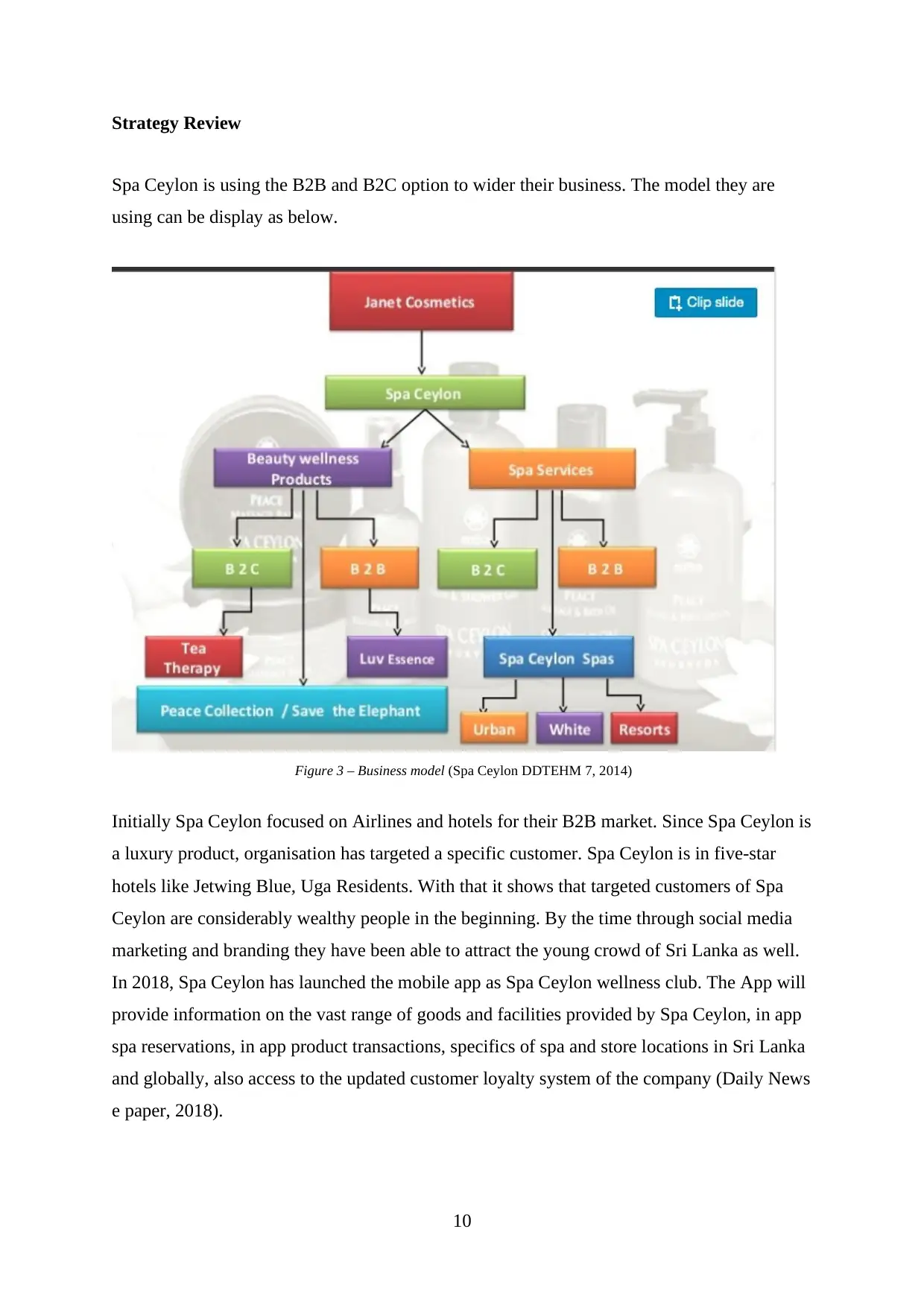
Strategy Review
Spa Ceylon is using the B2B and B2C option to wider their business. The model they are
using can be display as below.
Figure 3 – Business model (Spa Ceylon DDTEHM 7, 2014)
Initially Spa Ceylon focused on Airlines and hotels for their B2B market. Since Spa Ceylon is
a luxury product, organisation has targeted a specific customer. Spa Ceylon is in five-star
hotels like Jetwing Blue, Uga Residents. With that it shows that targeted customers of Spa
Ceylon are considerably wealthy people in the beginning. By the time through social media
marketing and branding they have been able to attract the young crowd of Sri Lanka as well.
In 2018, Spa Ceylon has launched the mobile app as Spa Ceylon wellness club. The App will
provide information on the vast range of goods and facilities provided by Spa Ceylon, in app
spa reservations, in app product transactions, specifics of spa and store locations in Sri Lanka
and globally, also access to the updated customer loyalty system of the company (Daily News
e paper, 2018).
10
Spa Ceylon is using the B2B and B2C option to wider their business. The model they are
using can be display as below.
Figure 3 – Business model (Spa Ceylon DDTEHM 7, 2014)
Initially Spa Ceylon focused on Airlines and hotels for their B2B market. Since Spa Ceylon is
a luxury product, organisation has targeted a specific customer. Spa Ceylon is in five-star
hotels like Jetwing Blue, Uga Residents. With that it shows that targeted customers of Spa
Ceylon are considerably wealthy people in the beginning. By the time through social media
marketing and branding they have been able to attract the young crowd of Sri Lanka as well.
In 2018, Spa Ceylon has launched the mobile app as Spa Ceylon wellness club. The App will
provide information on the vast range of goods and facilities provided by Spa Ceylon, in app
spa reservations, in app product transactions, specifics of spa and store locations in Sri Lanka
and globally, also access to the updated customer loyalty system of the company (Daily News
e paper, 2018).
10
Paraphrase This Document
Need a fresh take? Get an instant paraphrase of this document with our AI Paraphraser
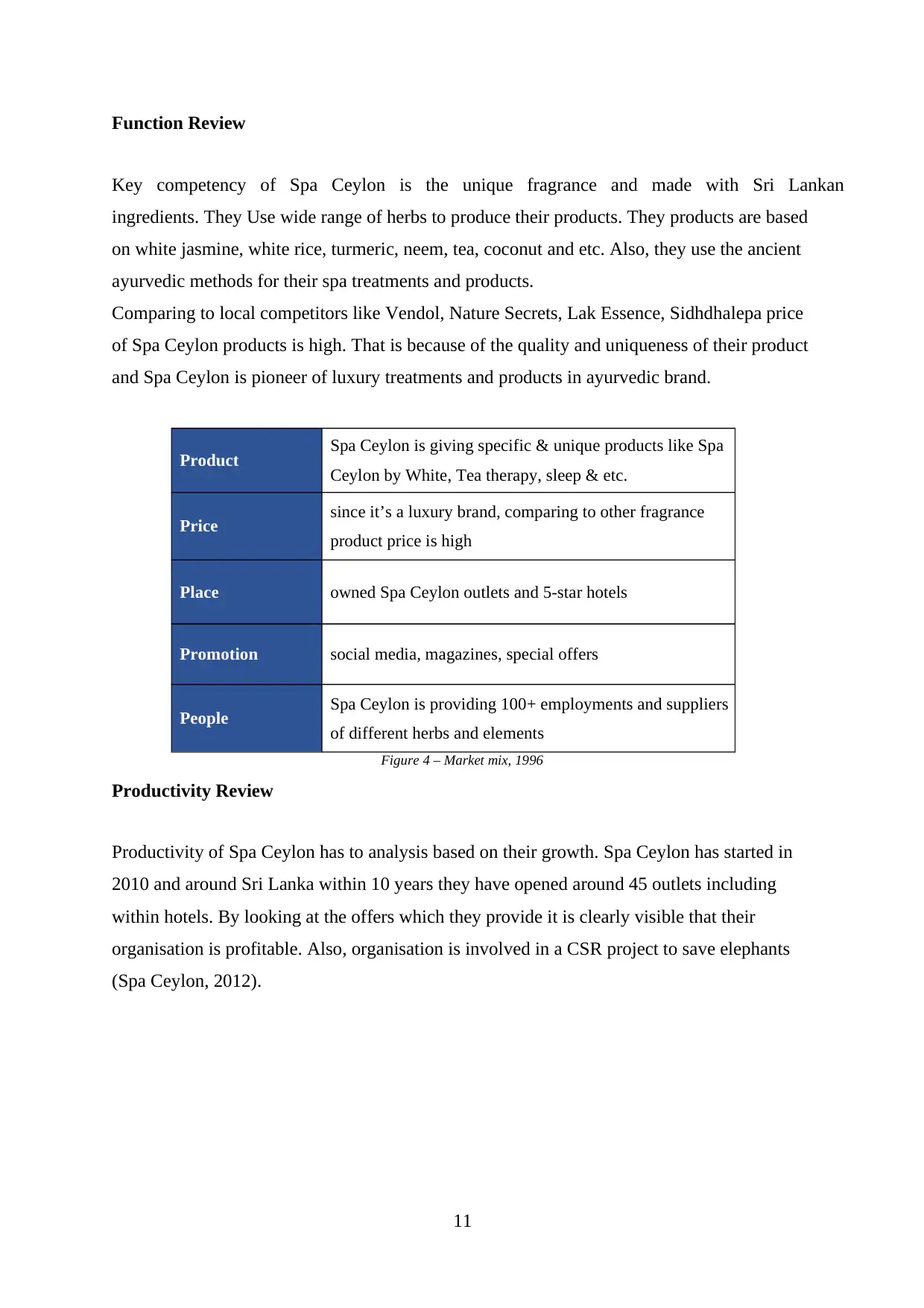
Function Review
Key competency of Spa Ceylon is the unique fragrance and made with Sri Lankan
ingredients. They Use wide range of herbs to produce their products. They products are based
on white jasmine, white rice, turmeric, neem, tea, coconut and etc. Also, they use the ancient
ayurvedic methods for their spa treatments and products.
Comparing to local competitors like Vendol, Nature Secrets, Lak Essence, Sidhdhalepa price
of Spa Ceylon products is high. That is because of the quality and uniqueness of their product
and Spa Ceylon is pioneer of luxury treatments and products in ayurvedic brand.
Product Spa Ceylon is giving specific & unique products like Spa
Ceylon by White, Tea therapy, sleep & etc.
Price since it’s a luxury brand, comparing to other fragrance
product price is high
Place owned Spa Ceylon outlets and 5-star hotels
Promotion social media, magazines, special offers
People Spa Ceylon is providing 100+ employments and suppliers
of different herbs and elements
Figure 4 – Market mix, 1996
Productivity Review
Productivity of Spa Ceylon has to analysis based on their growth. Spa Ceylon has started in
2010 and around Sri Lanka within 10 years they have opened around 45 outlets including
within hotels. By looking at the offers which they provide it is clearly visible that their
organisation is profitable. Also, organisation is involved in a CSR project to save elephants
(Spa Ceylon, 2012).
11
Key competency of Spa Ceylon is the unique fragrance and made with Sri Lankan
ingredients. They Use wide range of herbs to produce their products. They products are based
on white jasmine, white rice, turmeric, neem, tea, coconut and etc. Also, they use the ancient
ayurvedic methods for their spa treatments and products.
Comparing to local competitors like Vendol, Nature Secrets, Lak Essence, Sidhdhalepa price
of Spa Ceylon products is high. That is because of the quality and uniqueness of their product
and Spa Ceylon is pioneer of luxury treatments and products in ayurvedic brand.
Product Spa Ceylon is giving specific & unique products like Spa
Ceylon by White, Tea therapy, sleep & etc.
Price since it’s a luxury brand, comparing to other fragrance
product price is high
Place owned Spa Ceylon outlets and 5-star hotels
Promotion social media, magazines, special offers
People Spa Ceylon is providing 100+ employments and suppliers
of different herbs and elements
Figure 4 – Market mix, 1996
Productivity Review
Productivity of Spa Ceylon has to analysis based on their growth. Spa Ceylon has started in
2010 and around Sri Lanka within 10 years they have opened around 45 outlets including
within hotels. By looking at the offers which they provide it is clearly visible that their
organisation is profitable. Also, organisation is involved in a CSR project to save elephants
(Spa Ceylon, 2012).
11
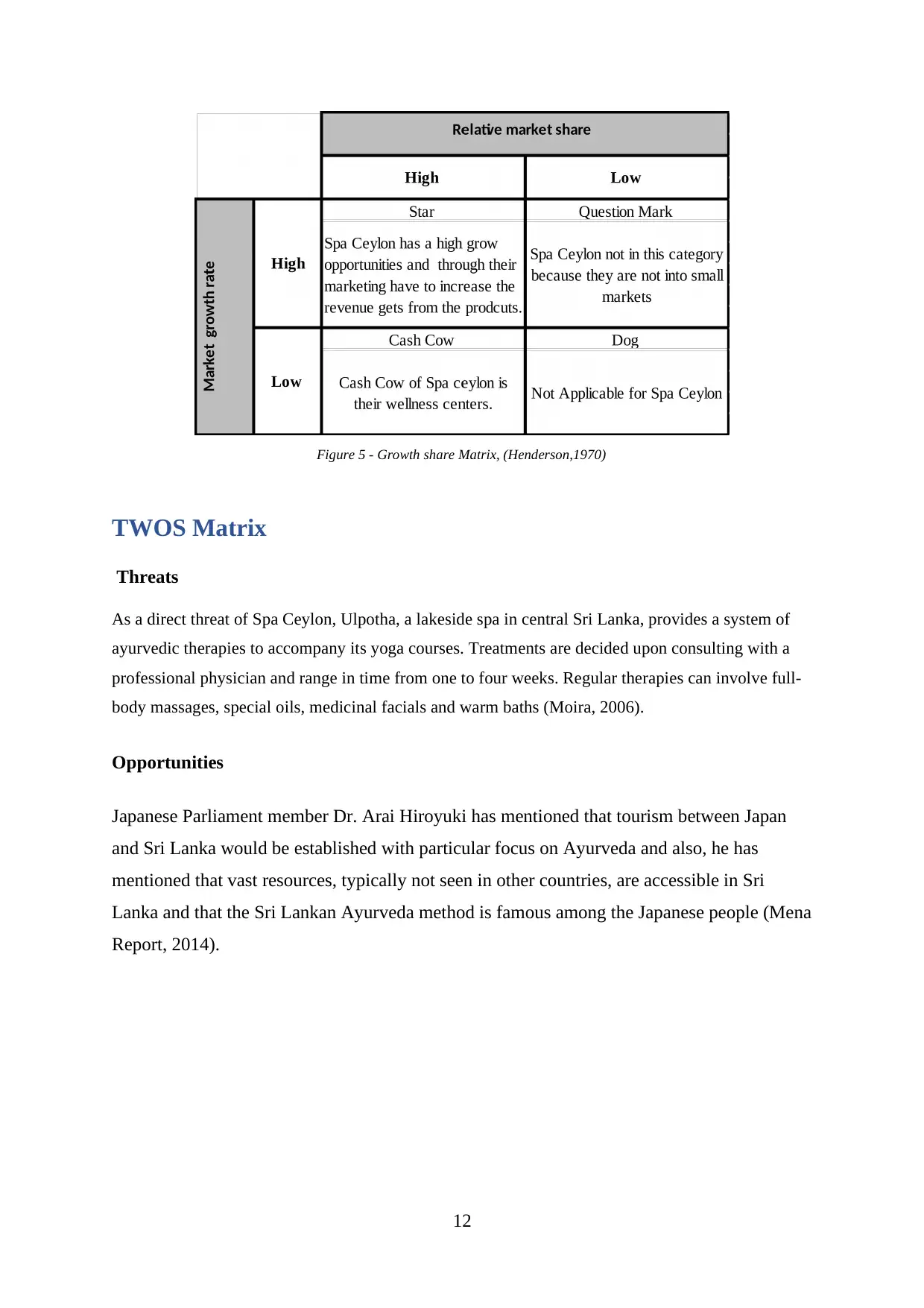
Figure 5 - Growth share Matrix, (Henderson,1970)
TWOS Matrix
Threats
As a direct threat of Spa Ceylon, Ulpotha, a lakeside spa in central Sri Lanka, provides a system of
ayurvedic therapies to accompany its yoga courses. Treatments are decided upon consulting with a
professional physician and range in time from one to four weeks. Regular therapies can involve full-
body massages, special oils, medicinal facials and warm baths (Moira, 2006).
Opportunities
Japanese Parliament member Dr. Arai Hiroyuki has mentioned that tourism between Japan
and Sri Lanka would be established with particular focus on Ayurveda and also, he has
mentioned that vast resources, typically not seen in other countries, are accessible in Sri
Lanka and that the Sri Lankan Ayurveda method is famous among the Japanese people (Mena
Report, 2014).
12
TWOS Matrix
Threats
As a direct threat of Spa Ceylon, Ulpotha, a lakeside spa in central Sri Lanka, provides a system of
ayurvedic therapies to accompany its yoga courses. Treatments are decided upon consulting with a
professional physician and range in time from one to four weeks. Regular therapies can involve full-
body massages, special oils, medicinal facials and warm baths (Moira, 2006).
Opportunities
Japanese Parliament member Dr. Arai Hiroyuki has mentioned that tourism between Japan
and Sri Lanka would be established with particular focus on Ayurveda and also, he has
mentioned that vast resources, typically not seen in other countries, are accessible in Sri
Lanka and that the Sri Lankan Ayurveda method is famous among the Japanese people (Mena
Report, 2014).
12
⊘ This is a preview!⊘
Do you want full access?
Subscribe today to unlock all pages.

Trusted by 1+ million students worldwide
1 out of 21
Related Documents
Your All-in-One AI-Powered Toolkit for Academic Success.
+13062052269
info@desklib.com
Available 24*7 on WhatsApp / Email
![[object Object]](/_next/static/media/star-bottom.7253800d.svg)
Unlock your academic potential
Copyright © 2020–2025 A2Z Services. All Rights Reserved. Developed and managed by ZUCOL.





